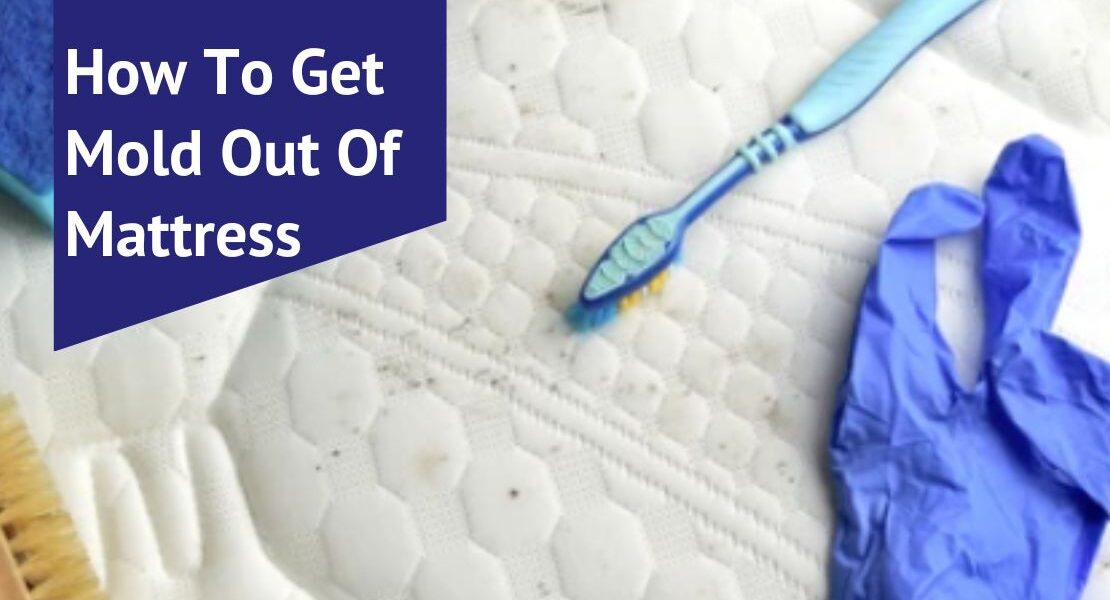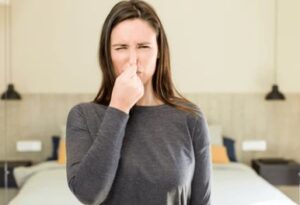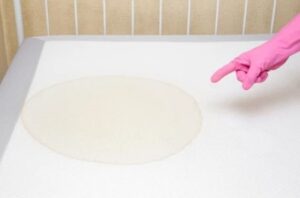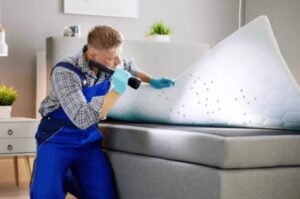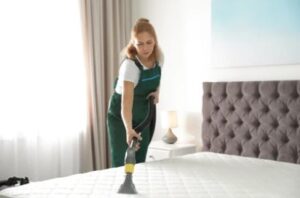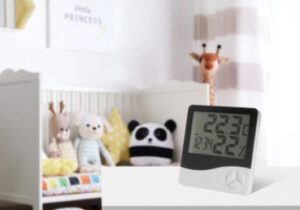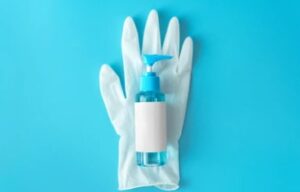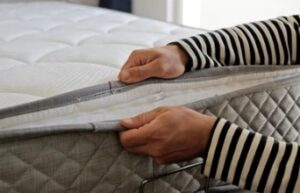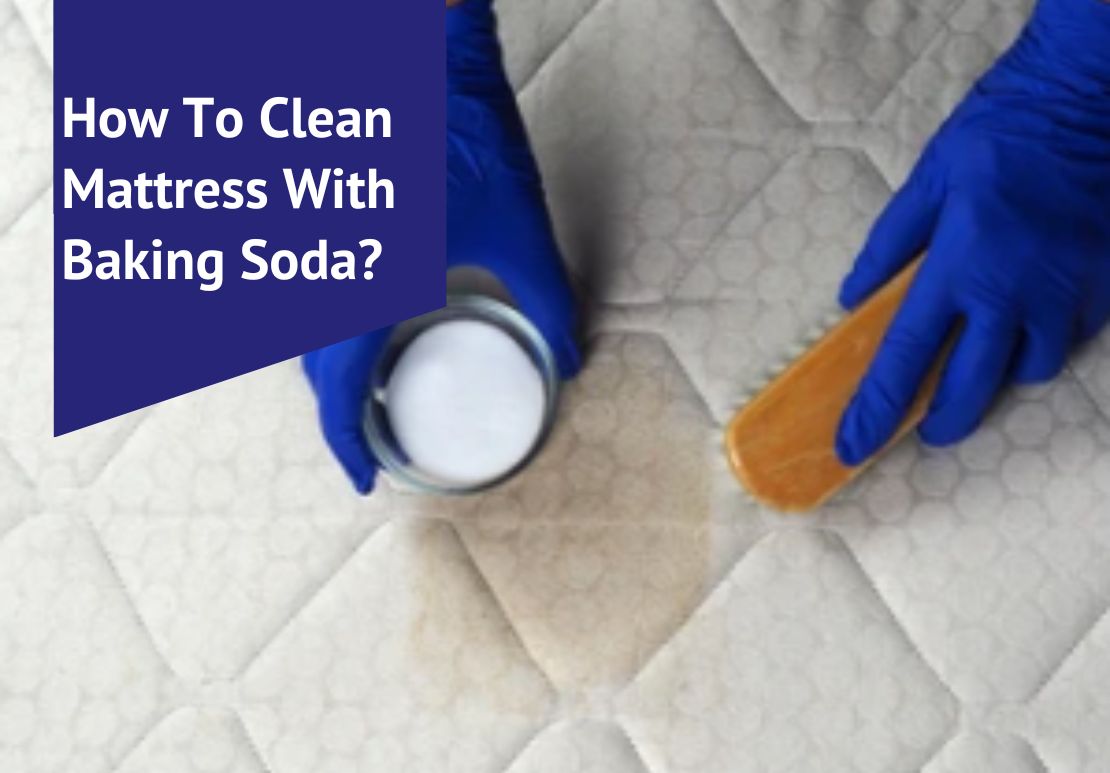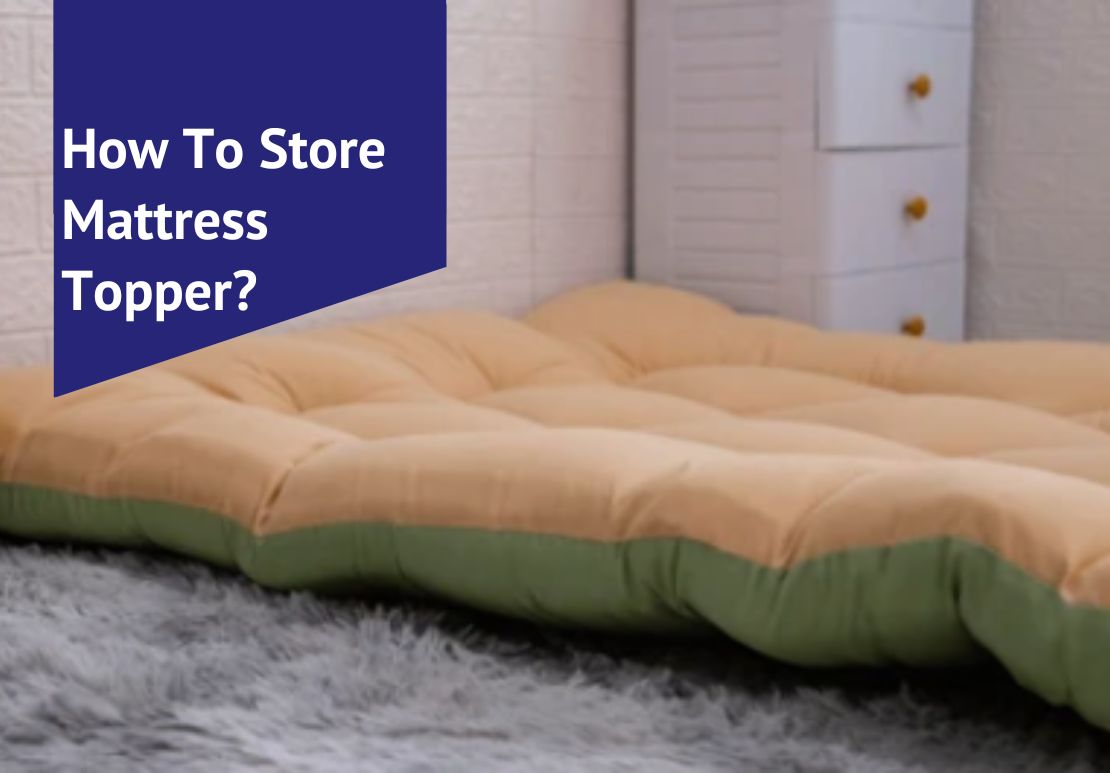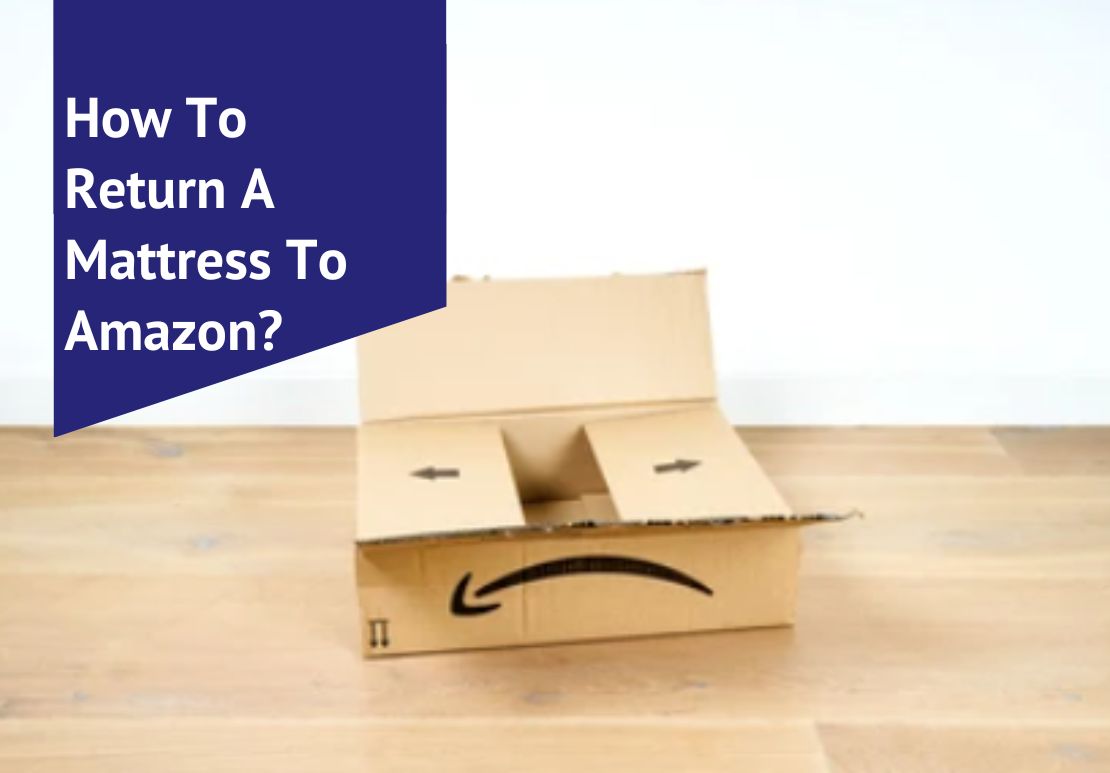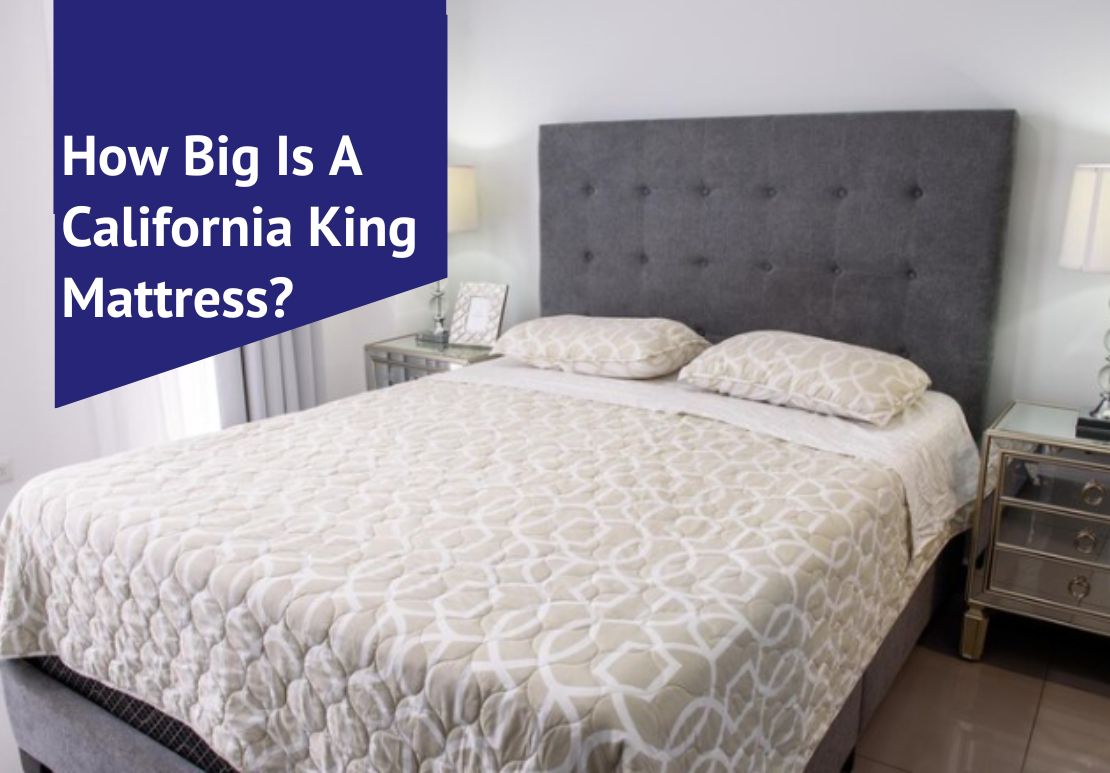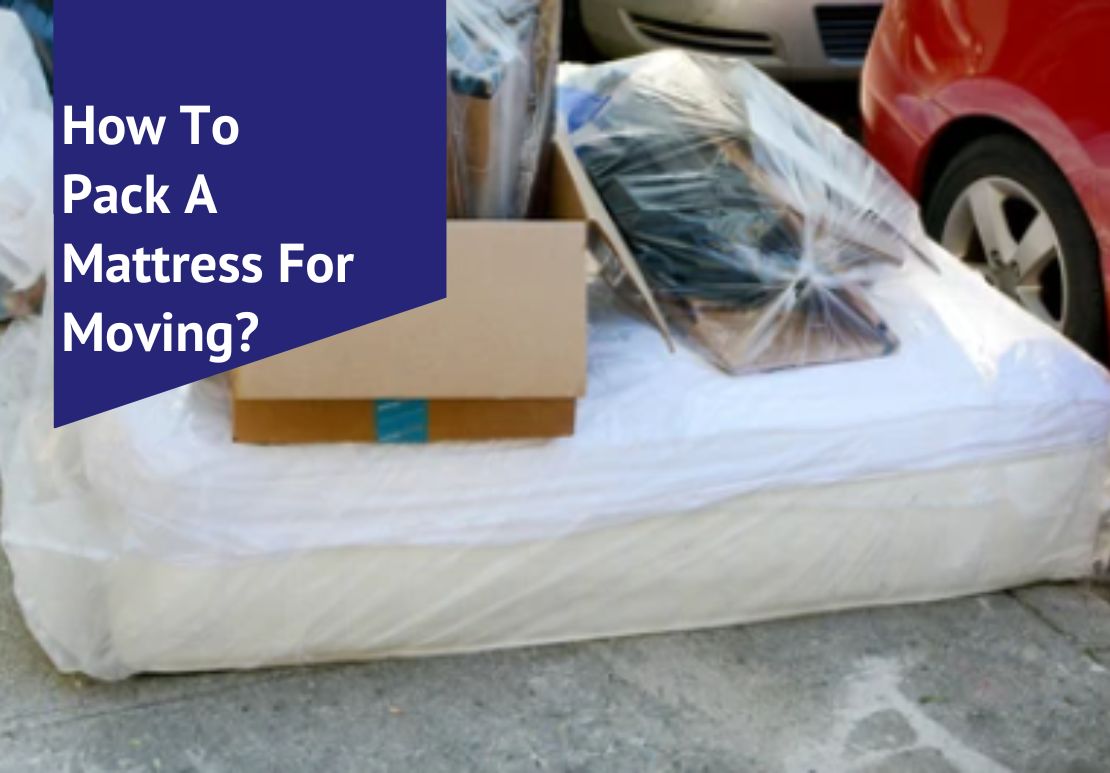Discovering mold in your mattress can be disturbing and discomforting. A common yet alarming issue, mold thrives in the damp darkness of bedrooms across countless homes. This article reveals a step-by-step method to eradicate mold from your mattress efficiently and safely, safeguarding your health.
Read on for trusted solutions that promise a cleaner sleep haven.
Table of Contents
Key Takeaways – To Free Your Mattress From Mold
- Identify signs of mold on a mattress, such as foul odors, stains, or allergy symptoms; addressing these signs quickly can prevent health risks and mattress damage.
- To eliminate mold from a mattress, vacuum it thoroughly to remove spores, then apply a cleaning solution like warm water mixed with rubbing alcohol or vinegar for stubborn stains. Rinse well and disinfect the mattress thoroughly in a ventilated area before drying it.
- Prevent future mold growth and get rid of mold on mattresses by keeping them dry and clean, using protective covers, controlling humidity levels in the room, increasing airflow and light exposure, and ensuring proper bed base ventilation.
- Regularly inspecting the bedroom for mold presence on walls or other furniture can help stop the spread of mold to your mattress.
- If you experience recurring issues with mold despite regular cleaning efforts, consider using antimicrobial products specifically designed to inhibit mold growth on surfaces.
How to tell if your mattress has mold?
If you notice a foul odor, stains, physical symptoms such as allergies or respiratory issues, pest infestations, or mold elsewhere in your home, these are all signs that your mattress may have mold.
It’s important to address the issue promptly to prevent potential health risks and damage to the mattress. Also, it is important to clean your mattress regularly to solve the mold problem and get the mold out of the mattress. The following points will help you know ‘how to know if your mattress has mold?’
Foul odor
A musty smell wafting up from your mattress can be a telltale sign that mold has made itself home. This unpleasant odor is often the first indicator homeowners notice before any signs of mold appear.
Mold thrives in damp environments, and when it grows on a mattress, it releases volatile organic compounds (VOCs) into the air, which are responsible for that distinct mildew scent.
Tackling this issue head-on means removing the source of the smell—the mold itself—and ensuring proper bed hygiene. Start with vacuuming your mattress to remove spores and debris.
Follow up by mixing an effective mold cleaning solution for mattresses; a 50/50 mixture of warm water and rubbing alcohol works wonders in killing off surface fungus without harming most mattresses.
Spray lightly onto affected areas, then pat dry thoroughly to prevent moisture from lingering. Regularly freshening your mattress with sunlight and maintaining low humidity levels in your bedroom helps keep foul odors at bay while safeguarding against allergen control issues like dust mites and mildew growth. Thus, it becomes important to search for ways when dealing with the question of ‘how to get mildew out of a mattress?’
Stains
One significant sign that mold might be lurking in your mattress is the presence of stains. These unsightly marks often have a green, black, or yellow hue and are an eyesore and an indicator of potential health risks.
Identifying mold on mattress surfaces at this stage calls for immediate action to prevent further growth and damage to the mattress and your health. Homeowners should tackle these mold stains head-on using cleaning solutions like vinegar or specially formulated mildew removers.
A mixture of rubbing alcohol and warm water can effectively remove these stubborn spots. It’s essential to clean the entire area with this solution, not just where the mold stain on the mattress is visible.
Scrubbing gently with a brush helps break up the mold growth before wiping it off entirely from your sleeping surface; thus, removing mattress mold must be thorough to ensure all traces are eliminated for good indoor air quality and bed hygiene.
Physical symptoms
If you’re experiencing allergy-like symptoms such as sneezing, coughing, or itchy eyes, these could be physical signs of mold in your environment. Mold on mattresses often triggers such reactions, especially in individuals with mold sensitivities or respiratory conditions like asthma.
Since mattresses are critical for a good night’s sleep and overall health, awareness of these symptoms can prompt an inspection for hidden mold.
Regular cleaning and mattress maintenance are the first lines of defense against the health risks of mold on mattresses. Ensuring proper air circulation around your bed and consistent cleaning routines can mitigate allergic reactions and safeguard your home from invasive mold growth.
Remember to inspect the top and underneath your mattress where hidden mold spores might lurk, waiting to cause discomfort or potential harm to you and your family.
Pest infestations
Pest infestations can be a sign of mold on your mattress. Dust mites and insects are drawn to the moisture and warmth provided by mold growth. Signs of pest infestation, such as increased allergy symptoms or visible bugs, should prompt immediate action to address the pests and the underlying mold issue.
Healthy sleeping environments require regular mattress maintenance, including addressing any pest issues that may arise. Keeping your mattress clean and dry will help prevent mold growth and unwanted pests from residing in your bed.
Mold elsewhere
Inspecting for mold elsewhere in the bedroom is crucial, as it can spread beyond the mattress. Check for signs of mold on other furniture, walls, and flooring. Use a flashlight to look under the bed and around corners where mold may thrive.
Remember that controlling humidity levels throughout the room can prevent mold growth, making regular inspection and maintenance essential to maintaining a healthy indoor environment.
Ensure that all surfaces are dry and free from moisture as much as possible. Implementing these precautionary measures will help safeguard against potential health risks associated with prolonged exposure to mold spores.
What causes mold on a mattress?
Moisture and humidity are the primary culprits behind mold growth on mattresses. When a mattress is exposed to these conditions, whether due to spills, leaks, or high indoor humidity levels, it creates an ideal environment for mold spores to thrive.
Additionally, poor ventilation and lack of sunlight can exacerbate the issue by trapping moisture within the mattress. Dust mites and pests also contribute by introducing organic material that molds feed on.
Inadequate cleaning practices may allow dust and other debris to accumulate, providing nutrients for mold growth.
Furthermore, if the mattress has been stored in a damp area or comes into direct contact with a moist surface like concrete floors or wet walls, this can also promote mold development.
The combination of these factors underscores the importance of regular cleaning and maintenance, keeping the sleeping environment dry and well-ventilated to prevent mold from taking hold on a mattress.
How to Prevent Mold Growth on a Mattress
To prevent mold growth on a mattress, it is important to clean and maintain it regularly, control humidity levels in the room, increase airflow and exposure to light, use antimicrobial products, employ protective barriers such as mattress covers or encasements, set up the mattress on a proper base, and take measures to prevent mold from developing under the mattress.
Regular cleaning to get rid of mold
To prevent mold growth on your mattress, homeowners should prioritize regular cleaning. Use a vacuum cleaner with an upholstery attachment to thoroughly clean the surface of the mattress at least once every few months.
Additionally, wiping down the mattress with 50:50 isopropyl alcohol and warm water can effectively kill surface mold and disinfect the area. Ensure that all sides of the mattress are cleaned using these methods, focusing particularly on areas where moisture may accumulate.
Regular cleaning is crucial to maintaining a healthy sleep environment and preventing mold from taking hold in your bedding. By following these simple steps, homeowners can effectively reduce the risk of mold growth on their mattresses and protect their health and well-being.
Controlling humidity
Controlling humidity in the bedroom is crucial to prevent mold growth on your mattress. High levels of moisture can create an ideal environment for mold to thrive. To address this issue, consider using a dehumidifier to reduce the humidity level in the room.
Additionally, ensuring proper ventilation by opening windows and utilizing fans can help circulate air and decrease moisture accumulation. By actively managing humidity levels, you can significantly diminish the risk of mold formation on your mattress.
Maintaining a healthy indoor environment involves proactively addressing high humidity levels. By employing these simple strategies, homeowners can effectively reduce the potential for mold growth on their mattresses and improve overall air quality within their homes.
Increasing air flow and light
Increasing air flow and light is essential to prevent mold growth on a mattress. Proper ventilation helps to reduce the moisture that molds thrive in. By opening windows or using a fan, you can create airflow that aids in drying out any excess moisture.
Additionally, allowing natural light into the room can help inhibit mold growth, as UV rays have antimicrobial properties. This simple yet effective approach can significantly contribute to mold prevention on your mattress.
By incorporating these strategies into your regular home maintenance routine, you can effectively minimize the risk of mold formation on your mattress while promoting a healthier living environment for you and your family.
Use of antimicrobial products
To prevent mold growth on your mattress, consider using antimicrobial products. These can include sprays or cleaners specifically formulated to inhibit the growth of mold and mildew.
Look for solutions that contain ingredients such as rubbing alcohol, vinegar, hydrogen peroxide, or isopropyl alcohol. Applying these antimicrobial products after thoroughly cleaning and drying the affected area can help prevent future mold issues.
Additionally, when purchasing a new mattress or protective covers, consider those with built-in antimicrobial properties to provide an extra layer of defense against mold and other harmful microorganisms.
Incorporating these products into your regular mattress maintenance routine can effectively reduce the risk of mold buildup in your sleeping environment.
Protective barriers
Consider using protective barriers such as waterproof mattress protectors to prevent mold growth on your mattress. These covers act as a barrier against moisture and spills, reducing the likelihood of mold development.
Additionally, they can be easily removed and washed to ensure a clean and healthy sleeping environment for you and your family.
Furthermore, investing in hypoallergenic encasements for your pillows and mattresses can provide an extra layer of protection against dust mites, allergens, and moisture – all contributing to mold growth.
By incorporating these protective barriers into your bedding maintenance routine, you can effectively safeguard your mattress from mold infestations while promoting a healthier sleep environment for years.
Proper base setup
Ensure a proper base setup for your mattress by placing it on a sturdy and breathable foundation. Use a bed frame with slats or a platform bed to allow air circulation, preventing moisture buildup that can lead to mold growth.
Additionally, consider using a waterproof mattress cover to protect the mattress from spills and accidents, which can contribute to mold development. Regularly inspect the base of your mattress for any signs of moisture or mold, and address any issues promptly before they worsen.
By setting up your mattress on an appropriate base and utilizing protective covers, you can significantly reduce the risk of mold formation. This proactive approach will help maintain a clean and hygienic sleeping environment while safeguarding your health from potential allergens associated with mold.
How to prevent mold under a mattress?
To prevent mold under a mattress, homeowners should regularly clean and vacuum the area. Controlling humidity levels using a dehumidifier or air conditioner can also inhibit mold growth.
Increasing airflow and allowing natural light into the room can help to keep moisture at bay. Using antimicrobial products on the mattress and surrounding areas is crucial for preventing mold from taking hold.
Additionally, investing in protective barriers such as mattress covers or encasements can provide an extra defense against mold infiltration.
Step-by-Step Guide to Removing Mold from a Mattress
Assess the situation by identifying the extent of mold growth and potential health risks. Adhere to safety precautions, such as wearing protective gear to prevent exposure to mold spores during removal. This is because mold exposure can cause several problems.
Vacuum the surface of the mattress to remove any loose mold spores and debris, then apply a cleaning solution specifically designed for mold removal. Rinse and disinfect thoroughly before allowing the mattress to dry completely in a well-ventilated area. Now, let’s look at how to remove mold from the mattress.
Keep reading to learn ‘how to remove mold spots from a mattress?’
Assessing the situation
Check for visible signs of mold, such as dark spots or patches on the mattress surface. Sniff for a musty odor emanating from the mattress, which can indicate the presence of mold.
Also, pay attention to physical symptoms like sneezing, coughing, or skin irritation when lying on or near the mattress. Take note if pest infestations are around or underneath the mattress, as they could be attracted to mold growth.
Inspect your mattress thoroughly if you’ve noticed mold elsewhere in your home.
Adhering to safety precautions
Before removing mold from a mattress, wear protective gear such as gloves, a mask, and goggles. Ensure the room is well-ventilated during the cleaning process by opening windows and using fans to increase airflow.
Avoid spreading mold spores by sealing off the affected area and containing any dust or debris generated during cleaning. Additionally, it’s important to carefully read and follow the instructions on any cleaning products used while keeping them out of reach of children.
Always use caution when removing mold from a mattress and prioritize your safety throughout the process. The next step involves vacuuming the surface with an upholstery attachment to remove loose mold spores before applying a cleaning solution according to the recommended guidelines for effective results.
Vacuuming the surface
After adhering to safety precautions, the next step in removing mold from a mattress is vacuuming the surface. Utilize a vacuum cleaner with a HEPA filter to remove any loose mold spores and debris from the mattress.
Ensure thorough coverage of the entire surface, focusing on seams, crevices, and any areas where mold may be visible or suspected. Following this step will significantly reduce mold’s presence before further cleaning and disinfection.
Once you have vacuumed the mattress surface, dispose of the vacuum bag promptly in an outdoor trash receptacle to prevent any potential spread of mold spores within your home environment. Thus, if your mattress is infected with mold, it is essential to vacuum it. Vacuuming will help you know how to remove mold from memory foam mattresses. Also, ensure that you read and follow the manufacturer’s instructions carefully first.
Applying a cleaning solution
After thoroughly vacuuming the surface of the mattress to remove loose mold spores and debris, it’s time to apply a cleaning solution. A 50:50 mixture of warm water and rubbing alcohol is highly effective.
Mix equal amounts in a disposable container, then lightly dampen a clean cloth with the solution, ensuring not to oversaturate the mattress. Gently blot the affected areas where mold is present, allowing the solution to disinfect by killing any remaining mold spores.
For tougher mold stains or persistent areas, a 50:50 blend of vinegar and water can also be used effectively. This natural cleaning solution offers potent antimicrobial properties that aid in eliminating stubborn mold on mattresses.
Rinsing and disinfecting
After applying the cleaning solution, thoroughly rinse the mattress surface with clean water. Use a sponge or cloth to gently scrub the area, removing any remaining mold and cleaning solution.
Once rinsed, disinfect the mattress by applying a 50/50 mixture of warm water and rubbing alcohol. This will help kill any lingering mold spores and bacteria while also aiding in drying the mattress more quickly.
Ensure you allow ample time for the mattress to dry completely before use. Properly ventilate the room and utilize fans to expedite the drying process. Ensuring that no dampness remains is crucial, as this can promote future mold growth if left unchecked.
Thoroughly drying the mattress.
To thoroughly dry the mattress, ensure ample airflow and sunlight exposure. Move the mattress outside to a sunny spot or open windows for natural ventilation.
Additionally, using a fan or dehumidifier can speed up drying and prevent mold re-growth. It’s imperative to ensure all moisture has been completely removed from the mattress before putting any bedding back on top.
Once you have finished thoroughly drying your mattress, it’s essential to inspect it carefully for any remaining signs of mold or dampness before proceeding with its regular use or storage.
Conclusion – To Get Rid of Mold From a Mattress
Taking prompt action is crucial in removing mold from a mattress. Begin by thoroughly assessing the situation and adhering to safety precautions before vacuuming the surface. Apply a cleaning solution, rinse, disinfect, and ensure thorough drying to prevent future mold growth.
Utilize the recommended cleaning solutions and disinfectants for an effective removal process. Remember that early detection and preventive measures are essential in maintaining a mold-free mattress for a healthy living environment.
FAQs – Frequently Asked Questions
How can I detect mold on my mattress?
Inspect your mattress for visible mold growth, which may appear as dark spots or patches. Also, check for a musty odor that indicates the presence of mold.
Can I clean mold from my mattress myself?
Yes, you can clean small areas of mold using a solution of water and mild detergent. For larger infestations, it's best to seek professional cleaning services.
What are the risks associated with sleeping on a moldy mattress?
Sleeping on a moldy mattress can lead to respiratory issues, allergies, and other health concerns due to exposure to airborne spores and mycotoxins.
How do I prevent mold from reoccurring on my mattress?
To prevent mold recurrence, ensure proper ventilation in the room by opening windows periodically and using a dehumidifier if necessary.
Can sunlight help in removing mold from a mattress?
Yes, exposing the affected area of the mattress to direct sunlight can aid in drying out moisture and inhibiting further mold growth.

